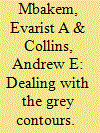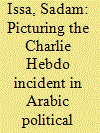| Srl | Item |
| 1 |
ID:
129096


|
|
|
|
|
| Publication |
2014.
|
| Summary/Abstract |
The categorization of displaced people is grounded in criteria enshrined by international and regional conventions as well as receiving states' asylum and immigration policies. However, drawing distinctions between displaced people remains a controversial issue because the causes of displacement are more diverse than the categories assigned. Whilst various categories confer different rights and entitlement, the forcibly displaced are often obliged to aspire to particular identities driven by their resettlement livelihood objectives. This paper is based on a study carried out in Brazzaville, Republic of Congo and Newcastle upon Tyne, United Kingdom. The paper argues that the institutional and policy environments in the locations where resettlement is sought determine the way displaced people identify themselves in displacement and how they appraise their circumstances and their consequent adaptive livelihood reconstruction strategies. Furthermore, it is shown here that formalized displacement categorization adds complexity to the way displaced people must deal with their circumstances and negatively impacts on livelihood adaptation. Whilst categorization may serve perceived institutional needs, this study finds that displaced people's self-identification makes them resilient and enables survivability.
|
|
|
|
|
|
|
|
|
|
|
|
|
|
|
|
| 2 |
ID:
147388


|
|
|
|
|
| Summary/Abstract |
This article investigates how the Arabic political cartoons picture the mocking cartoons of the Prophet Muhammad by the French satirical Charlie Hebdo magazine.1 It is noticed that the cartoons utilize the Charlie Hebdo incident as a locus to deconstruct the unjustness and bias of the Arabic leadership and the international community in their dealing with some Arabic political issues. The surveyed cartoons also used the Charlie Hebdo incident as a locus to formulate the Palestinian “imagined community” (Anderson, 1991). I argue that the surveyed cartoons use the strategy of “differentiation” (Meyer, 2000) based on the self vs. other dichotomy to establish this deconstruction and imagined community. The study uses the semio-linguistic and visual rhetorical tools (Barthes, 1972), and self-categorization (Turner, 1987) to achieve this deconstruction, through an analysis of semiotic-discursive aspects of a small corpus of Arabic political cartoons. The findings indicate that promoting a discourse of fear and danger toward the inside and outside actors is what constitutes this self-other-based identity.
|
|
|
|
|
|
|
|
|
|
|
|
|
|
|
|